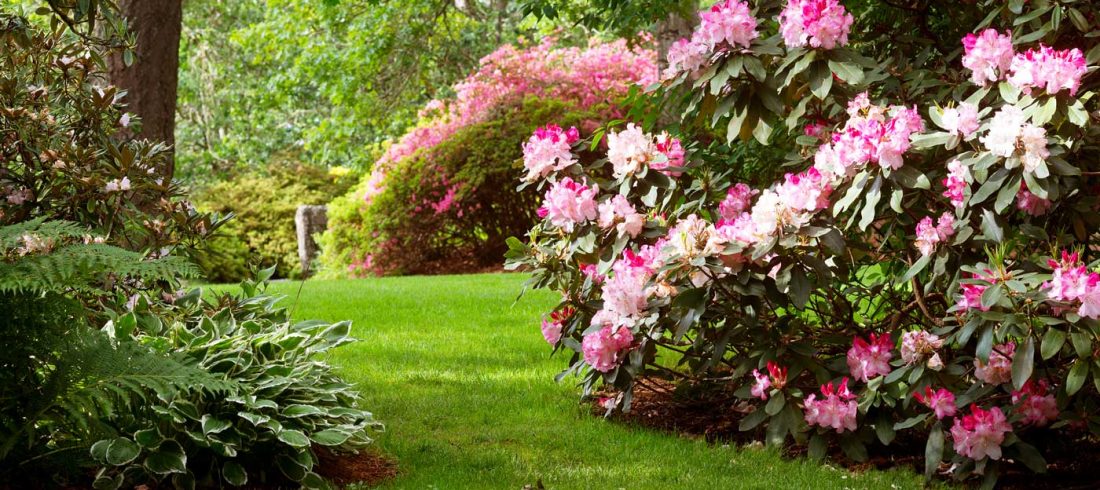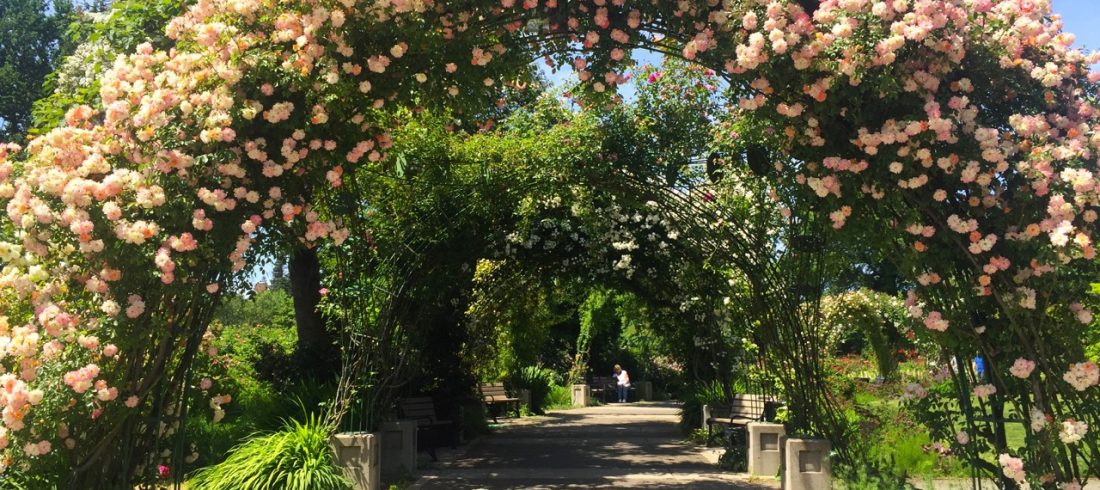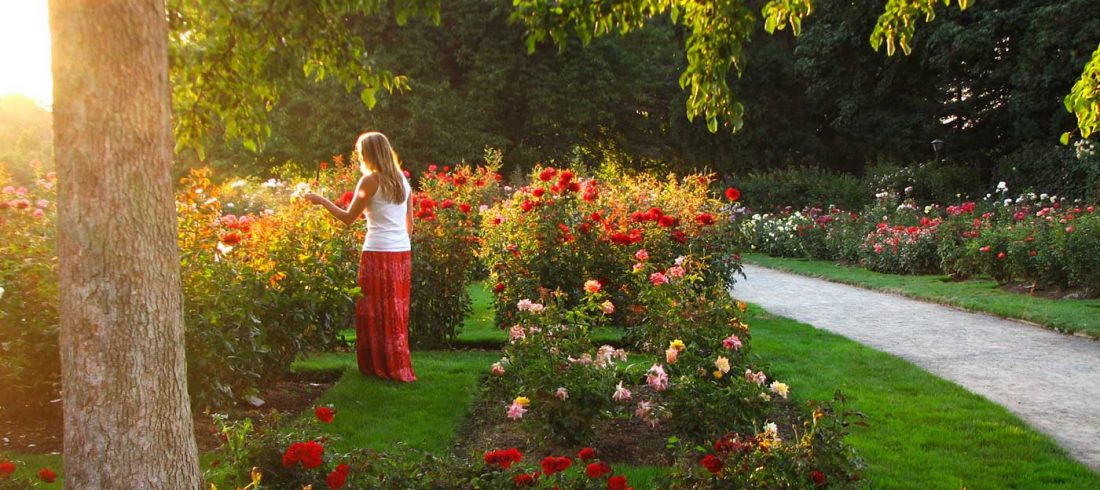Wicked winter weather is no friend to local horticultural treasures. Just ask the gardeners responsible for the acres of rhododendron, rose, and native plant beds scattered across Eugene’s two most beloved public parklands, Hendricks Park and Owen Rose Garden.
As this year’s spring buds awaken, park personnel can breathe a collective sigh of relief; the damage to plants they’ve labored to repair after this unusual winter weather is giving way to renewed plant growth and floral rainbows.
No, it’s not been an easy winter for the gardeners: unparalleled ice damage to all manner of plants; a mountain of work orders to clear broken trees, hanger limbs, and widow makers; tons of brush picked up and hauled away by a parade of trucks.
The collective park maintenance demands left precious little time to keep pace with all the usual caretaking chores that, for decades, have been the foundation of Eugene’s most prized public floral landscapes.
But keeping pace is what the gardeners do. With skill and pride.
“These are very diverse gardens with lots of perennials,” says Emily Aune, lead gardener for Hendricks Park and its daunting acreage of rhododendrons, native plant beds, and urban forestland. “I landscaped for years before I came to Hendricks, and there are so many plants here that I’d never heard of. I feel a sense of obligation to maintain the history of Hendricks, and the work of the two head gardeners that came before me. They were here for 25 years apiece. They put their hearts and souls into their work.”

Picnic on a ridge
Hendricks Park is the oldest park in Eugene. In 1906, Thomas Hendricks and his wife, Martha, deeded 47 acres of local hilltop land to the city for the community’s first public parklands. Eugene’s mayor at the time, Francis Wilkins, followed suit by facilitating the city’s purchase of 31 adjacent acres. It’s said that the idea for the public park grew out of a discussion between the Wilkins and Hendricks families during a picnic on the ridgeline where the park now stands.
Prior to European settlement of the Willamette Valley, the Hendricks Park region was open oak woodland and savannah habitat. The landscape foliage was largely a product of the native Kalapuya tribe’s practice of regularly burning prairies and savannah lands. With the cessation of burning, the Hendricks parkland evolved into a Douglas fir woodland landscape with scattered stands of mature white oak.
Over the past century, Hendricks Park has morphed into transitional old-growth forest with protected oak stands and an island of open space bisected by gardens and forest trails surrounded by residential neighborhoods. But for most visitors, there’s one particular aspect of Hendricks Park that draws special love. “Our main prize,” says Aune, “is the 13 acres of rhododendron gardens. It’s all manicured beds and trails and hillside. And it’s huge.”

Scent of roses
A few miles northwest of Hendricks Park, perennial love also blooms alongside the Willamette River in the Owen Rose Garden. More than 100,000 annual visitors stroll the neatly manicured trails winding through 8.5 acres of roses and cottage garden flower beds boasting more than 400 varieties of rose and other flowers. The garden includes a gazebo, pergola, and an amazing black tartarian cherry tree said to be the oldest (170 years) and largest of its kind.
The Owen Rose Garden, Eugene’s second-oldest public park, was donated to the city in 1951 by lumberman George Owen. The land was the first parcel of parkland in what today constitutes the section of the Willamette Greenway running from the Ferry Street Bridge to the Greenway bike bridge near Valley River Center.
Shortly after Owen donated the acreage, the Eugene Rose Society donated 750 rose bushes. Today, the park still includes many of the original heritage and heirloom plants, plus many newer rose varieties. The plants will produce nearly 5,000 individual blooms this spring
That’s a heck of a lot of roses—a fact that weighs on Daphne Sampson, Owen’s lead gardener. As any rose breeder or backyard grower will attest, managing roses is labor intensive. For Sampson, that intensity translates into weekly work plans that balance planting, mulching, weeding, fertilizing, pruning, and general landscaping responsibilities across all the seasons. Mother Nature is known for tossing curveballs on occasion, so Sampson routinely reviews calendar information detailing plant behavior and landscaping procedures at Owen Rose Garden each of the past four years.
“There are windows for doing everything,” says Sampson, who confesses that pruning strategies, insect damage, plant diseases, and yes, weather, make rose gardening a high-maintenance endeavor. “But on the other hand,” she adds admiringly, “roses are pretty tough!”

Help from friends
If park caretaking were left wholly in the hands of the Eugene Parks staff, it’s fair to assume that the city’s floral treasures would be in serious jeopardy. The amount of work required approaches overwhelming. Not enough good can be said about the volunteer work crews and special nonprofit organizations that have invested themselves in maintaining the beauty of Hendricks and the Owen Rose Garden. Their efforts help offset the challenges of public budget constraints and limited park staffing.
Eugene Park Stewards, for example, coordinates volunteer work teams for the twin premier parks. Regular Thursday work parties at the Owen Rose Garden offer volunteer helpers experience in rose pruning, planting methods, fertilizing, and general care. The tradeoff is increased attention to the gardens. Other community organizations, key among them the Eugene Delta Rotary, have provided stewardship to Owen in recent years by shepherding through a major garden renovation and by recruiting regular work crews.
Hendricks Park also draws huge support from weekly volunteer work crews that offer lifeline caretaking services to the cottage gardens and rhody beds. Other volunteer crews provide trail care in the urban forest—allowing paid staff to invest more time in showcase garden areas.
But the ongoing efforts of the nonprofit organization Friends of Hendricks Park are perhaps the most critical to the long-term sustainability of Hendricks’s perennial gardens.
Since 2001, the Friends have recruited and organized weekly work parties to help meet routine park caretaking needs. They advise city staff on annual park goals and planning. They’ve purchased and planted uncountable flowers and other foliage. And they’ve designed and completed a wide variety of special projects ranging from the establishment of the native plant garden to annual bed rebuilding, terrace construction, and the orchestration of education programs and student tours.
“I adore the Friends,” says head gardener Aune. “Some of them are great gardeners. They make my job so much better.”
Time of the season
Blooms are bodacious, yet the perennials in Eugene’s twin showcase parks also have beauty and magic enough to hold most visitors’ interest well outside peak blooming season.
Different rhododendron varieties, for example, blossom at different times in different seasons. There’s even a rhody variety that blossoms in February. But even when rhodies aren’t blooming, they boast beautiful bark formations, and the off-season offers opportunities for exploring the intriguing branch structures of the multi-hued plants.
Coneflowers, black-eyed Susans, and echinacea in the cottage beds of Hendricks Park attract goldfinches, who feed on seed heads after blooms die off in late summer. In autumn, downy woodpeckers arrive in the gardens to pick at the heads of the weedy perennial mullein. Birds, reptiles, flying insects, and furry mammals abound in both Owen Rose Garden and the assorted flower beds of Hendricks on any day, in any season.
But there’s no better time to savor the complex beauty of Eugene’s premier flower garden parks than springtime leaning into early summer. It’s the season when floral enchantment floats on breezes. It’s the time when rich floral scents and rainbow colors excite the imagination.
For visitors to Hendricks Park and the Owen Rose Garden, springtime is high season for perennial love.


